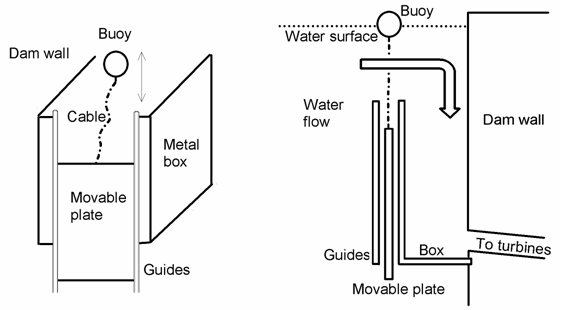Hydropower Switched to Dual Clean and Renewable Energy Source
Narrowly linked to climate change issues, this article is intended to somehow foresee the rise of a new clean and renewable energy resource. We are talking about methane (CH4), a powerful greenhouse gas that is usually produced through the biodegradation of organic compounds in the absence of oxygen. Methane is the second most important greenhouse gas, which has a global warming potential (GWP) over 20 relatively to CO2 for a time horizon of 100 years. Biomethane gas is an end-product of well-known biosystems such as wetlands, landfills, rice paddies, termites and ruminant enteric fermentation, while thermogenic methane, or natural gas, is physically formed under very specific conditions in the earth crust and in deep oceans (methane hydrates), similarly to the genesis of fossil fuels.
National Institute for Space Research, INPE, S. J. Campos, Brazil.
Methane gas has a combustion heat of 55.7 MJ/kg. Considering efficiency factors in energy conversion (Bambace et al., 2007), 1 million tonnes of methane corresponds to an equivalent power production of about 420 MW. When burned in thermopower facilities, methane is converted into CO2 and in terms of net carbon emission to the atmosphere, the use of biogenic methane is preferable than natural gas, because it is renewable and the emitted CO2 was formerly in the atmosphere - it was captured by photosynthetic processes, transformed into organic matter and biodegraded to methane. In contrast, if biomethane derived from anthropogenic activities are not used for energy purposes, and escapes to the atmosphere, it accumulates for about 7-8 years (its lifetime) and contributes to the enhancement of the global warming. The increasing and persistent leaks of the anthropogenic methane are responsible for a hasten increase in its concentration in the atmosphere during the last century (Etheridge et al., 2002).
The majority of projects agreed under the Kyoto Protocol of the United Nation Convention on Climate Change are reliant on the recover of biomethane from very specific anthropogenic sources, mainly sludge derived from industrial, sewage, wastewater and landfill treatment processes. A recent communication in Scitizen made by Fearnside (2007) showed that renewable hydropower are also significant sources of methane to the atmosphere, so hydropower could not be considered "clean energy" under the strict sense of the Kyoto protocol. However, what if we were able to prevent such emissions and recover the non-emitted biomethane for power generation, likewise for the sludge treatment plants? We found one of the several possible solutions to do so (Bambace et al., 2007).
Reservoirs can be partially recognized as huge biodigestors degrading organic carbon produced via photosynthesis. In brief, biomethane is produced in the sediments, where there is almost no oxygen. It reaches the atmosphere by diffusion through the water column, by convective mixing, and through ascending gas bubbles that eventually escapes from the gas-saturated sediments. The fate of biomethane in natural lakes is the oxidation by bacteria (a larger fraction) in more oxygenated superficial waters or the emission to the atmosphere (a smaller fraction). Therefore deeper reservoirs tend to oxidize larger fractions of biomethane (Lima, 2005). On the other hand, reservoirs present a "hidden river flow" in mid to deep waters induced by the water suction of turbines and spillways that markedly change the biomethane upshot in these environments. As a result, a non-negligible fraction of the biomethane that should be oxidized is then transferred downstream the dam. Due to a sudden change of pressure and great turbulence, dissolved biomethane in water is promptly degassed and emitted to the atmosphere (see Fearnside's analogy with the opening of a bottle of soda). The remainder biomethane is steadily emitted or oxidized on the course of several kilometers downstream (Kemenes et al., 2006; Guerin et al., 2006). Therefore an appropriate mitigation system should focus on turbine and spillway methane emissions.
Bambace et al. (2007) have proposed a system consisting of a gate-buoy that allows only superficial waters to be turbined (or spilled) downstream (see Figure 1). The buoy keeps the gate at a desired level where most biomethane is largely oxidized into CO2. On the other hand, it would be more advantageous if another system were used in deep waters to recover the biomethane for energy purposes earlier to surface oxidation. A recovery system developed in the African Kivu Lake can be seen here. Note however that Kivu Lake reaches a depth of 480 meters, allowing great accumulation of biomethane and auto-siphon phenomenon that cannot be expected for shallower (usually < 100 meters) reservoirs. Hence, Bambace et al. (2007) proposed an alternative system that uses nighttime hydropower to recover and store biomethane from deep waters of the reservoir, as hydropower demand during the night is substantially reduced and could be redirected to this finality.
Figure 1. Gate-buoy system to mitigate methane emissions downstream large dams.
-
12/12/12
“Peak Oil” is Nonsense… Because There’s Enough Gas to Last 250 Years.
-
05/09/12
Threat of Population Surge to "10 Billion" Espoused in London Theatre.
-
05/09/12
Current Commentary: Energy from Nuclear Fusion – Realities, Prospects and Fantasies?
-
04/05/12
The Oil Industry's Deceitful Promise of American Energy Independence
-
14/02/12
Shaky Foundations for Offshore Wind Farms







 Read more
Read more
Replace "Scientizen" with "Scitizen"